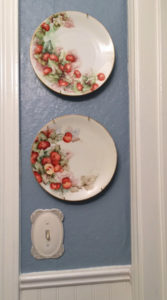This is something that has been developing over the last … decade or so. Maybe a bit longer, since when the Daughter Unit came home from the Marines with all her worldly possessions and parked most of them in the garage. A garage into which a lot of domestic detritus had flowed in addition, starting with some excess furniture, held against the day when the Daughter Unit ever had her own establishment, the camping gear from when we did indeed camp … and a number of boxes of stuff which may not even have been properly unpacked from when I bought the house in the spring of 1995 and a grateful USAF-hired subcontractor in the moving profession parked them within. My final delivery of PCS delivery of household goods, after eight moves over twenty years. I ought to take pictures of the boxes, as they are unearthed. (This is not anywhere near a record in the military world. I managed to remain at one place for six years, practically a lifetime homesteading, as these things go.) To all this was added various gleanings by myself and the Daughter Unit – but I swear, until about a decade ago, we could – with a bit of a squeeze – get two cars into the garage.
Until the garage door crapped out, and I could not afford to have it replaced at that time. And then … well, Fibber McGee’s closet had nothing on the garage. It was to the point where stuff was just lost within. A kind of domestic storage black hole, although if we opened the door from the hallway into it, there was nothing like the noisy, prolonged cavalcade of stuff falling. It was at a point where there was barely a path from the door to the freezer, and that was when the hot-water heater gave up the ghost last year. I still think that the hot-water heater should have been retained in a utility-plumbing museum someplace, for it was proved by the plumbers who replaced it, to have been the original install to the house, and had faithfully provided hot water for thirty years, when it rightfully could have been forgiven for collapsing after ten or so.
Anyway, in that grand final collapse, the hot-water heater flooded the near regions of the garage, and I lugged out several trashcan-loads of ruined and moldy stuff over the days that followed – mostly those shoes and clothes in which my daughter was no longer interested in. When the Daughter Unit returned from California this spring – we agreed to sort out the garage, now that the door and automatic lifting mechanism was on my schedule to be replaced. We have now been working on that project since Monday. Much has to be sorted, and inevitably, much of it consigned to the trash, or to the local Goodwill outlet, although we did make a side trip yesterday to a local recycling enterprise with the back of the Montero loaded with what could be construed as metal or technological scrap with a metal component. Based on our last visit there, the Daughter Unit suggested an over-under. She placed a bet on over $15, but I went for under $10. We got a whole $1.50 for the trouble.
Goodwill, though – any more trips to the nearest Donation Station, we will be on a first-name basis with the unloading-assistance people. Clothes – mostly hers, outgrown, unneeded. The futon mattress, hopefully to be reunited with the frame, which went to Goodwill last month. (Yes, it took that long to wade through the detritus in the garage to get to it.) Extraneous appliances – how on earth did we finish up with two or three coffee makers when only one of us drinks coffee? The old yoghurt-maker, from when I was a newly-minted sergeant with a toddler, living in Mather AFB enlisted housing, on a shoe-string budget, when my biggest monthly bill be for the day-care center, and I cut corners in all kinds of ways, including brewing yoghurt from milk and a couple of dollops of the previous batch. An extraneous blender, a couple of framed pictures which once ornamented the Daughter Unit’s room … and a whole raft-load of old magazines. I had subscriptions to Gourmet, the Smithsonian, and a selection of others; most of them I passed on to other readers (my next-door neighbor in Athens, Kyria Penny adored reading my old Atlantic and Harpers issues), or disposed of, once read, but like back issues of the National Geographic – those magazines accumulated. And accumulated. And accumulated. Well – nice, readable, interesting magazines, and once one has paid for them … well, anyway, it was time to do a clean sweep. I never once went out to the garage to look up back issues and keeping them seemed distinctly hoarderish to me. So – out they have gone, piled up in garbage bags next to the recycle bin.
We did a culling of the boxes of books out there, as well, as well as some stuff that once I was sentimental about – like the framed posters I had on the walls of my barracks room, an age ago. A handful of books are reprieved, the rest packed into bags and wished on the good people of Goodwill, and the posters are for the chop. Yesterday, we emptied and demolished a pair of cheap utility shelves – one from Spain, where it used to hold the kitchen things, the other inherited from Dave, the Computer Guy. Gone, waiting for trash collection, their contents culled, repacked and re-shelved if we decided to keep. Today – emptied and moved the two shelves that we will be keeping, and re-shelved stuff. The bags full of trash await collection. Next week, we’ll call on Neighborhood Handy Guy and his pick-up truck, to help us ferry a couple of box springs and mattresses (one of the box springs is unused!) and the bicycles – the old three-speed that I took to Korea for the year to serve as my basic transport, and the kid’s bicycle that the Daughter Unit had in Spain. Sentiment is all very well, but these bikes were ordinary, nothing otherwise special – and we need the space in the garage.
My ambition, actually – is to be able to walk across the garage with my eyes closed, and not trip over anything. The purpose for all this is so that we can get the garage door replaced, and be able to park at least one of the cars inside, by the time that I finish paying Neighborhood Handy Guy for the bathroom renovation.
The first of two projects for 2019 – part of the grand Five-Year Plan for improving Stately Hayes Manor is nearly accomplished. That is, the renovation – in one portion down to the very wall studs – of the master bathroom. (The second will be clearing out the garage and installing a new garage door.) This was an utterly bland, undistinguished pair of small rooms, completed in contractor-grade fittings, tile and features sometime in 1985. I most particularly hated the tub and the tile enclosure surrounding it, for the tile seemed to be incapable of ever being scrubbed clean, as the grout between the tiles shot through with mold. The tub finish was also disintegrating. I had refinished it once myself, to cover up a patch where the porcelain had worn through to metal, but even the refinished portions had become incapable of being cleaned. The dressing area was filled across one wall with a vanity and single sink set into a fake stone countertop – also nearly incapable of being cleaned, without being sand-blasted, and a wall-to-wall mirror. Both of these features made the dressing are seem small and cramped.
So, after refinishing the small bathroom last spring, the master bath was on my list; and I began collecting pictures on Pinterest and from other sources, of bathroom spaces which appealed to me and were readily doable: newer and smaller vanity, a walk-in shower with a glass door instead of a tub, and definitely a newer toilet with a more efficient and powerful flush … and as for the rest, a kind of refined country, early 20th century look emerged from the collection of pins and pics. A pattern of tile which went on sale for less than $3.00 a square foot on Wayfair set the colors … and in mid-January I started clearing out what I could. Over January, Neighborhood Handy Guy and his hard-working #1 Minion finished demolishing that which I could not manage myself … and the new elements began going in: anaglypta wallpaper from Wayfair on ceiling, woodwork, bead—board paneling, and floor tile from Lowe’s, a pair of light fixtures from Amazon … all the necessary bits and bobs. The woodwork got painted white, the upper walls blue, to match – and as of this week, it is all but done. I did the painting and wallpaper, NHG and #1 Minion did the rest. Behold the before, during and after!
- Demolishing the Tub enclosure
- Having scraped the popcorn texture off the celing
- A View into the roomettes when demolition was underway
- The hated dressing area vanity
- The anaglypta wallpaper, unpainted
- The Dressing area, once stripped out and partially painted
- The pile of stuff to go INTO the bathroom
- The ceiling – papered with more anaglypta and the crown molding installed
- A view through from the master bedroom
- The floor tile, and pale blue tinted grout
- A couple of design elements, re-installed
- The shower enclosure
- The new light fixture in the dressing area
- The new storage cupboard
- The new WC, installed
- More design elements in the dressing area
- The medicine cabinet door – behind the framed bird print
One of those things that I have practically had to make a chart for, when writing about Luna City – is keeping track of the vehicles which the various characters drive; they are mentioned now and again, and over seven (and this year to be eight books) I have to try and be consistent. Car ownership – make, model, style, color and condition – say something about the personality of the driver/owner. Herewith the run-down; as near to complete a listing of those motor vehicles (not necessarily automobiles or trucks) which I have noted in passing:
Berto Gonzalez: he routinely drives an assortment of luxury town cars and limousines as part of being employed by his Uncle Tony, who owns a car-hire service catering to the up-scale market. Berto also routinely drives a rather down-at-heels pickup truck owned by his father; a vehicle with a cracked vinyl seat patched with duct tape. He does not yet own his own personal vehicle, as he has no real need to do so.
Jess Abernathy-Vaughn: a bare-bones yellow Jeep Wrangler.
Joe Vaughn: ordinarily behind the wheel of the Luna City PD’s one cruiser, or one of the department’s sport-utility vehicles. His personal vehicle is a pickup truck, model unspecified, but of solid quality and well-maintained. Joe is fastidious, that way.
Doc Wyler: a very recent model Ford F-150 King Ranch model pickup, with the cattle-brand designed logo of the Wyler Ranch on the doors, and all the add-on bells and whistles. Doc is a man accustomed to the best and has the means to acquire and maintain such.
Sefton and Judy Grant: The Grants operate – and barely manage to keep it street-legal in the eyes of the motor vehicle licensing authorities – a vehicle pieced together from an old Volkswagon bus, with a pickup-truck bed welded to the back half of the chassis, behind the driver and passenger seats. The sides of the truck bed and the doors to the driver/passenger compartment are spray-painted with flowers, peace signs and vintage hippie mottoes, in between the rust.
Miss Letty McAllister: she does not drive.
Richard Astor-Hall: he does not drive, either.
Chris Mayall: a recent model Mitsubishi hatch-back; bright red in color. Chris, like Joe, is fastidious about vehicle maintenance, and is still annoyed at the bill for bodywork incurred when he collided with a deer – even though the Gonzalez Motor and Auto Body shop gave him the friends-and-family rate. Chris blames the deer for reckless grazing.
(to be continued)
Honestly, I just meant to get a screwdriver from the toolbox in the garage, and go about my soon-to-be-renovated bathroom, taking down the glass shelf, the towel hook and the little glass vases in nickel-finished holders – all the hardware that I am going to reuse because I liked it very much, and they were pretty expensive when I first purchased them from Crate and Barrel when I did some superficial redecorating of the master bathroom shortly after moving in.
But I found the putty knife when I was going through the toolbox (which I will need to scrape that disgusting popcorn texture off the ceiling) and the big hammer … I am going to be using all of them in the next few days anyway. Yes, I walked into the bathroom with the hammer and began bashing away at the tile surround, just to see how difficult it would be. What with one thing and another, about a third of the nasty stuff is removed. This is featureless white contractor-grade tile of no particular merit, with the grout between permanently grotty and incapable of ever being thoroughly clean … well, I just got carried away, mostly with how much I hate that nasty cheap bathtub and shower surround in the master bathroom. It turns out that although water had seeped through the tile surround at the angles, and where it joined the top of the bathtub – there was not as much catastrophic rot and water-damage as I had feared. Although the drywall immediately underneath is so decayed that it crumbles like chalk, and I can pull it away with my bare hands. Here I thought that the drywall underlay for tile in bathrooms and all – was supposed to be the extra-heavy moisture-resistant stuff with the green paper coating. This wasn’t. It was the ordinary stuff, and moisture had gotten into it. No wonder I couldn’t keep the crud at bay in the grout. This is not the first structural omission I have found in my house, but at least this one will be remedied soon.
The first shipment of the replacement tile for the shower enclosure arrived yesterday – which is what brought all this on. I ordered it from Wayfair, because I liked the looks, and it was on special-reduced sale at an acceptable $2-3 per square foot – a traditionalish pattern in what looked like pale blue on a cream background and would suit the new walk-in shower enclosure. The UPS delivery guy is going to get an extra-special large box of fudge next Christmas, because the boxes with the tile are darned heavy – and little doeth he know that there will be two more boxes next week, as well as the new vanity – which I also ordered off Wayfair, because it also came up on sale; exactly what I wanted for an early 20th century and country look – wainscoting halfway up the walls, anaglypta wallpaper on the ceiling and dressing-room walls, hexagonal white tile on the floor, archaic-appearing faucets and fixtures.
First thing today, I took one of the bathroom tiles down to Lowes’ to match the paint for the walls and woodwork. It turns out that on close examination – the background is more of a white with a bluish cast, and the figure is almost a slate grey-blue. A challenge to match, but the woman at the paint counter took it as her personal mission to do so. Now I have a gallon each of whitish-with-a-blue cast, and slate-grey-bluish paint piled up with the other stuff which will play a part in the renovation, and an ambition to clear out as much as I can, single-handed, before mid-week, when Neighborhood Handy Guy and his pickup truck and I go to collect the last of the necessary materials which don’t fit easily into the back of the Montero.
The new home renovation project for this year has commenced, in a small way. This is the renovation of the master bathroom – number three on my grand five-year plan for sorting out the tiny suburban bungalow – which in another two years will be entirely paid off, mortgage-wise. It was once my ambition to do a second mortgage, once the first had been paid in full, and use the profits from sale of the California raw acreage to purchase a half-acre in the Hill Country and build my dream house on it. This probably will not happen, although I still have hopes of the Adelsverein Trilogy or the Luna City series suddenly (and miraculously) attaining the popularity and stratospheric sales figures of Fifty Shades of Grey, or the Outlander series, and enable us to buy a substantial property and build a bespoke mansion on it. But hope is not a plan – and this; this is the Five-Year Plan to sort out the present house, and make it fit for a local author with modest tastes, a huge library, and a tasteful collection of career mementos to live in.
So – the master bathroom becomes the next item on the list after renovating the guest bath (AKA Blondie’s bathroom), the new roof, and the Amazing Catio. Those three items were completed last spring; the Catio is almost completely paid for. Time to move on to the next two projects; the garage – now a good part cleared out in preparation for a new door – and the master bath.
This facility is a pair of rooms about five by five feet each, as laid out by the construction firm which built most of the Spring Creek Forest subdivision over three decades. They were one of the better firms, which meant that the constructor-grade appliances and installed fixtures were not absolute dreck, constructed from paper straws, tinfoil and bottom-grade cabinets of compressed wood chips and a thin vinyl veneer, and purchased by the railcar-sized lot. (Seriously, when Neighborhood Handy-guy ripped out the small bathroom vanity last year, I demolished it myself with a carpenter’s hammer, and stuffed the remains into the ordinary trash can.) More »


















Recent Comments